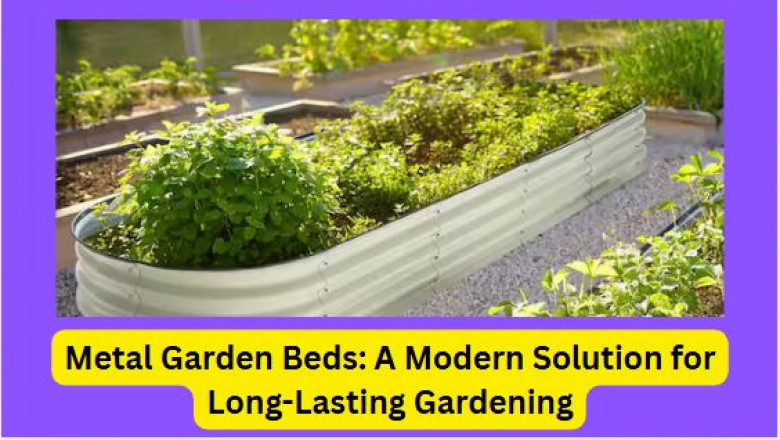views
Metal garden beds are revolutionizing home gardening with their sleek design, unmatched durability, and low-maintenance appeal. Whether you're a beginner or a seasoned green thumb, metal garden beds offer an excellent way to grow flowers, vegetables, and herbs with style and practicality. In this guide, we'll explore why metal garden beds are a top choice, how to use them effectively, and what to consider before setting one up in your space.
What Are Metal Garden Beds?
Metal garden beds are elevated planters made from materials like galvanized steel, aluminum, or corrugated metal. Unlike traditional wooden beds, they are highly resistant to rot, weather, and pests. These beds come in various shapes, sizes, and finishes, making them suitable for any type of garden—from backyard plots to small patios and rooftops.
Why Choose Metal Over Other Materials?
Durability
Metal garden beds are built to last. Galvanized steel, in particular, resists rust and corrosion even in harsh climates. While wood can rot or attract termites, and plastic may crack or fade, metal remains strong year after year.
Low Maintenance
Once installed, metal garden beds require little upkeep. No need for yearly treatments or repairs—just fill with quality soil and start planting.
Clean and Modern Aesthetic
Metal beds give your garden a polished, contemporary look. They're perfect for both rustic and modern garden designs and can even double as decorative focal points.
Eco-Friendly Options
Many metal beds are made from recycled materials and are 100% recyclable at the end of their lifespan, making them a sustainable choice.
Pest Resistance
Unlike wood, metal isn’t a food source for insects. It's also harder for burrowing pests like gophers or moles to get through.
How to Set Up a Metal Garden Bed
Setting up a metal garden bed is easy, even for first-time gardeners. Here’s a step-by-step breakdown:
1. Choose the Right Location
Select a spot that gets 6–8 hours of sunlight daily. Make sure it's level and close to a water source.
2. Prepare the Ground
Clear any grass or weeds. If you're placing the bed over soil, add a weed barrier (like cardboard or landscape fabric) and consider a layer of gravel for drainage.
3. Assemble the Bed
Most metal beds come with easy-to-follow assembly instructions. Use gloves to protect your hands, as metal edges may be sharp.
4. Add Soil
Use a well-draining soil mix, such as:
-
50% topsoil
-
30% compost
-
20% perlite or coconut coir
5. Start Planting
Once the soil is in, you’re ready to grow! Choose crops based on the season and your region’s climate.
Best Crops to Grow in Metal Beds
Metal garden beds are excellent for growing:
-
Leafy Greens (lettuce, kale, spinach)
-
Root Vegetables (carrots, radishes, beets)
-
Tomatoes & Peppers
-
Herbs (basil, parsley, mint)
-
Small Fruits (strawberries, bush blueberries)
You can also use trellises or cages for climbing plants like cucumbers, beans, or peas.
Are Metal Beds Safe for Gardening?
Yes—galvanized metal garden beds are completely safe for growing food. Galvanized steel is coated with zinc to prevent rusting. Studies show that the small amount of zinc that may leach into soil is minimal and non-toxic to humans or plants.
Tip: To reduce any leaching even further, line the interior of your bed with landscape fabric or install a plastic barrier if desired.
Tips for Long-Term Success
-
Avoid Overheating: In hot climates, metal can absorb heat. Prevent soil from overheating by:
-
Adding mulch on top of the soil
-
Watering in the early morning
-
Placing beds in areas with partial afternoon shade if possible
-
Check for Drainage: Always ensure there are drainage holes or layers to prevent water from pooling.
-
Winter Maintenance: Metal beds can stay outside year-round. To prolong their life, clean them at the end of each season and check for rust or dents.
Popular Styles of Metal Garden Beds
Rectangular Beds
Great for lining fences, patios, or pathways.
Round Beds
Perfect for central planting areas or small decorative gardens.
Tiered Beds
Offer a beautiful, cascading look and are ideal for companion planting or maximizing space.
Comparison: Metal vs. Wood Garden Beds
FAQs About Metal Garden Beds
1. Do metal beds get too hot for plants?
Not usually. While metal does conduct heat, the soil acts as insulation. Using mulch and watering regularly will protect roots even in warmer temperatures.
2. Will galvanized metal rust over time?
Galvanized metal is treated to resist rust. However, over many years and with exposure to acidic soils, minor rusting may occur—but it’s generally cosmetic and won’t impact bed function.
3. Can I place a metal garden bed on concrete?
Yes. Just ensure proper drainage by adding a layer of gravel or placing the bed on pot feet or bricks to allow water to escape.
4. How deep should a metal garden bed be?
A depth of 12–18 inches is ideal for most vegetables. For deeper-rooted crops like tomatoes or carrots, aim for 18–24 inches.
Conclusion
Metal garden beds are a smart, stylish, and long-lasting choice for anyone serious about gardening. They offer numerous benefits—from pest resistance and modern aesthetics to eco-friendliness and durability. Whether you're growing food for your family or designing a beautiful outdoor retreat, metal beds provide the structure and support your garden needs to thrive.






















Comments
0 comment